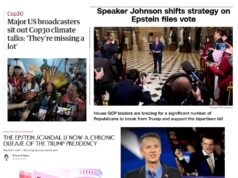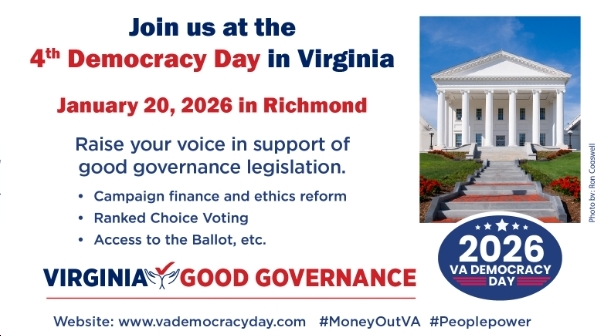It’s been five years, believe it or not, since the Virginia Democratic “trifecta” passed and signed into law one of the most consequential bills in years, the Virginia Clean Economy Act. What has the bill accomplished? Arguably, it’s been held back by a number of factors, including local “NIMBYism,” plus fossil-fuel-industry-instigated opposition, plus some serious environmental concerns about forests, etc., to building clean energy projects. Also, of course, as some of us pointed out five years ago and since then:
- The Virginia Clean Economy Act was far from perfect. As Ivy Main wrote at the time: “The bill that emerged from the [sausage] grinder inevitably allows Dominion Energy to profit more than it should. (Welcome to Virginia, newcomers.) The energy efficiency provisions, which I thought weak, became even weaker, then became stronger, then ended up somewhere in the middle depending on whether you were looking at the House or Senate version. The renewable portfolio standard, complicated to begin with, is now convoluted to the point of farce — and to the extent I understand it, I’m not laughing.”
- The Virginia Clean Economy Act’s timeframe was at least a decade too slow. As I wrote back in March 2021: “One of the biggest problems with VCEA – as I pointed out to one of the leaders on this bill at the time, only to be told that I wasn’t being “realistic” or some bullshit – is its baffling lack of ambition, given plummeting costs for clean energy and the urgency of combatting the climate crisis (emphasis on the word *crisis*). Currently, for instance, VCEA requires “Dominion Energy Virginia to be 100 percent carbon-free by 2045 and Appalachian Power to be 100 percent carbon-free by 2050.” Wait, what??? This is going to take until 2045 and 2050? As in, 24 years and 29 years from now?!? To put it mildly, that seems like an awfully long time – FAR too long! – given the urgency of the climate crisis and the economics of clean energy vs. fossil fuels.”
- Here’s an analysis of the initial version of the Virginia Clean Economy Act. As I wrote at the time: “Bottom line – the Virginia Clean Economy Act has positive aspects, but in many ways is a bill that would have been great 5 or 10 years ago. Today, given dramatic advances in clean energy technology and costs, we can go much further/faster than in the past, and we absolutely should do so. Actually, strike the words “should do so” and replace them with “must do so,” given the fact that almost every day, a dire new report comes out about the extreme urgency of dealing with the climate crisis. At this point, after wasting so many years thanks to fossil fuel companies, their bought-and-paid-for political allies, etc., we are really out of time, and certainly don’t have decades (e.g., until 2050) to ditch the fossil fuel addiction that’s rapidly heating up the planet, acidifying the oceans, and driving species – including our own, if we don’t act – to extinction.”
- At the time, the bill was mostly opposed by Republicans, because they’re totally in the pocket of fossil fuels and apparently REALLY hate having a healthy, livable environment. There was also some opposition from the left, which basically argued that we needed a Green New Deal (sure, but there was no chance of that passing, plus the legislation on that subject was not well-written or a particularly serious piece of legislation) and that the VCEA wasn’t nearly ambitious enough (agreed). Where I strongly disagreed with those who weren’t happy with the VCEA was in their argument that the legislature should vote down the VCEA, basically because it wasn’t the Green New Deal, wasn’t strong enough, etc. My view, and the view of almost every environmental and clean energy group out there, was that VCEA should be passed as a *starter* – then should be strengthened significantly in coming years. Unfortunately, it hasn’t been strengthened since then, which is very frustrating…and still an agenda item if/when Democrats retake a governing “trifecta” this November.
I’d just add a few other points about complicating factors in terms of analyzing the impact of the Virginia Clean Economy Act:
- First of all, it’s very difficult to know how much impact the VCEA had on Virginia’s clean energy growth, compared to the impact of improved clean energy economics in general (note that clean energy has been booming across America and the planet, so it’s most definitely NOT a Virginia-specific phenomenon). Without the VCEA, would clean energy be growing in Virginia? Almost certainly. Would it be growing as quickly? Hard to say, but…probably not?
- Second, it’s very difficult to untangle the impacts of the state-specific VCEA from national, pro-clean-energy policies, such as in the Inflation Reduction Act. Again, if you look across the country, clean energy has been booming…in states with strong clean energy legislation, but also in many “red” states (e.g., Texas) without a VCEA equivalent.
- Third, in general, it’s likely that clean energy would have grown in Virginia with or without the VCEA, if for no other reason than the economics of building new power capacity have shifted dramatically over the past couple decades in favor of utility-scale (and to a lesser extent distributed) solar, onshore (and to a lesser extent offshore) wind, energy storage, etc. See here for the new edition of Lazard’s annual report on “Levelized Cost of Energy” and you’l see what I’m talking about: namely, that “Unsubsidized Wind & Solar Lowest Cost Generation Sources for Last 10 Years”; “Gas-Fired Generation Reaches 10-Year High LCOE”; “Storage Cost Decline: Significant YOY Declines Offset 2021 – 2024 Increases, Dropping LCOE to 2020 Level”; etc. That’s why solar and wind power have been supplying most U.S. electric generation growth, and why they were (prior to the current Big Bad Ugly Bill monstrosity) projected to continue to do so into the future.
Anyway, with those (major) caveats in mind, here’s an analysis of the VCEA’s impacts, by the clean energy industry and other advocates for clean energy (comments by me in parentheses/italics/green after each item).
- The overall argument is that “The Virginia Clean Economy Act is delivering lower energy bills, new jobs, and a healthier environment” (Sure, to the extent VCEA is responsible for those things – see the caveats I listed above)
- VCEA “jumpstarted investment in renewable energy, created jobs, and began transforming our energy grid to serve all Virginians.” (That was the idea. So where are we right now? According to Dominion Energy’s 2024 VA Integrated Resource Plan, in 2025 they expected natural-gas-fired power generation to account for 48% of their overall power generation capacity mix, with nuclear at 13%, solar at 9% and wind still at zero. However, Dominion does show future growth in renewable power, with solar expected to hit 28% in 2039, and solar/wind/battery energy storage systems (BESS) expected to hit 48% in 2039. Which is below what VCEA calls for, requiring Dominion Energy to purchase significant amounts of Renewable Energy Credits – RECs – in 2039. On the positive side, according to Dominion’s IRP, “Since the passage of the VCEA, Dominion Energy has petitioned for the SCC approval of 3,636 MW of Company-owned solar projects and solar PPAs in its annual Renewable Portfolio Standard (“RPS”) Development Plan proceeding. 18 Most of these projects and PPAs have received SCC
approval and are in the development, construction, or operation phase.” And, of course, “In December 2022, Dominion Energy received SCC approval of the commercial portion of the CVOW [Coastal Virginia Offshore Wind] Project, which represents nearly 2,600 MW of clean energy. It is proceeding on time and on budget and is expected to be in-service by the end of 2026.”) - “Since the VCEA passed in 2020, carbon pollution from power plants dropped 22%.” (This seems to be more the result of switching from coal to natural gas, which would reduce C02 emissions of course, since coal is more carbon-intensive than natural gas, BUT would also increase emissions of the potent greenhouse gas methane, which leaks into the atmosphere during natural gas extraction and transport. That’s a big problem, and largely cancels out the benefits of lower CO2 emissions from coal-to-gas switching.)
- “118,100 clean energy jobs in Virginia.” (Good, to the extent VCEA is responsible for that – see the caveats I listed above)
- “Since the VCEA passed in 2020, 11% increase in Virginia’s GDP.” (This seems like a big stretch – Virginia’s GDP increased since 2020 for a bunch of reasons, along with GDP in the rest of the country. The question is, how much of that was driven by growth in the clean energy economy.)
- “Dominion Energy’s latest Renewable Portfolio Standard (RPS) plan projects saving $118.5 billion in fuel costs savings over the lifespan of VCEA clean economy project investments.” (Sure, to the extent VCEA is responsible for that…but yes, solar and wind power have zero fuel costs, so the more of those power sources we produce, the bigger our fuel cost savings.)
- “$2.8 to $7 billion in health cost savings over 20 years. By 2045, the VCEA will save 32 lives per year across the state, and avoid up to $355 million per year in health-related costs.” (Sure, to the extent VCEA is responsible for reducing power plant pollution; no question, there are huge health costs stemming from fossil fuel emissions…)
P.S. Of course, with US Senate passage of the Republicans’ horrible budget bill, the future of the US (and Virginia) clean energy economy is now very much in doubt…



![Saturday News: “Trump’s latest tariff TACO probably won’t make your life more affordable”; “The Epstein Email Cache: 2,300 Messages, Many of Which Mention Trump”; “[MTG] questions if Trump is still the ‘America First’ president”; “Jim Ryan tells all: ‘What did the Governor know, when did he know it?’”](https://bluevirginia.us/wp-content/uploads/2025/11/montage1115-238x178.jpg)








![Saturday News: “Trump’s latest tariff TACO probably won’t make your life more affordable”; “The Epstein Email Cache: 2,300 Messages, Many of Which Mention Trump”; “[MTG] questions if Trump is still the ‘America First’ president”; “Jim Ryan tells all: ‘What did the Governor know, when did he know it?’”](https://bluevirginia.us/wp-content/uploads/2025/11/montage1115-100x75.jpg)
